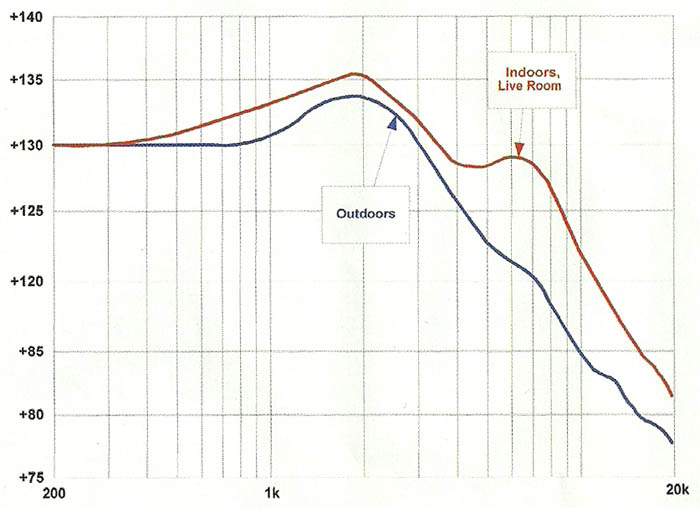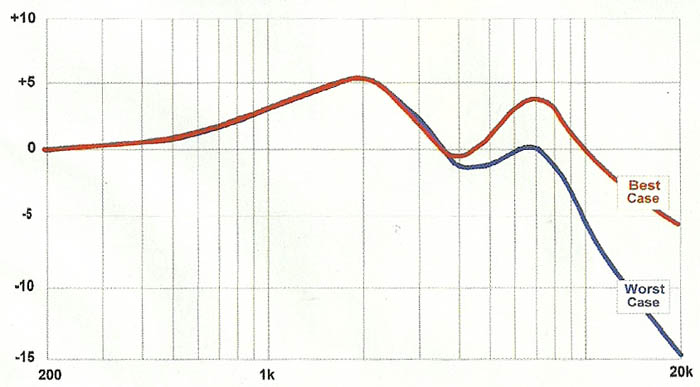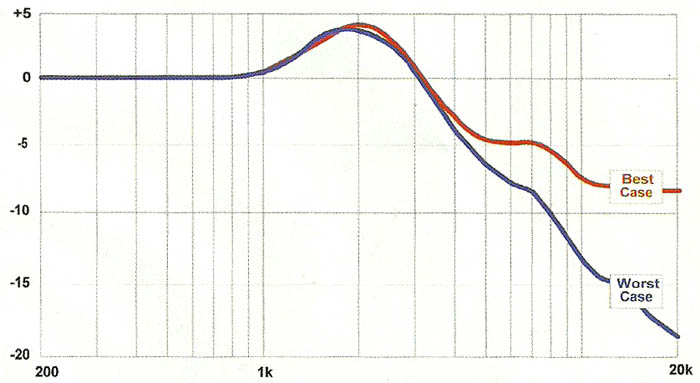
PUTTING ALL THE CURVES TOGETHER
Effective Power-Bandwidth Response (EPBR)
To understand the array’s performance in an actual gig, we combine the ear’s transfer function with the array’s power bandwidth response.
The result is a curve that I will call the Effective Power-Bandwidth Response (EPBR).
The EPBR is the perceived maximum sound pressure that the array can deliver. “Perceived” means that the curve is adjusted for the ear’s transfer function.
As we’ve seen, the ear’s transfer function is different in reverberant and non-reverberant venues, so we have to handle those two cases separately.
None of these curves include any effects of air attenuation. If air attenuation were to be included, it would make things look even worse!
Figure 7 shows the EPBR for reverberant (indoor) and non-reverberant (outdoor) venues: Did you ever hear a line array in an arena gig and wonder why it sounded pretty good, but only up to about 7-8 kHz? I certainly have.
As you can see, for outdoor shows the problem is severe. Who hasn’t been to an outdoor show where everybody was blaming the wind for the lack of high end, or the heat, or the humidity.
Clearly, they’re not the only issue.
Effective Headroom (EH)
To see how the EPBR affects a particular show, we must compare it with the spectral content of the audio program. I define the term Effective Headroom (EH) as the difference between the EPBR and the spectral amplitude curve of the program material.
As we saw, the estimated spectral content curve depends on the type of program material and on who’s doing the estimating.
Indoors
The best-case scenarios use Dennis Bohn’s spectral content estimate, the worst-case ones use mine. Here they are, in Figure 8 for reverberant venues. This isn’t too bad – best-case headroom is only 5 dB down at 20 kHz.
If it’s well run, the rig would lose openness and airiness at high levels, but otherwise would probably sound OK. However, an intense high-SPL high frequency experience would not be available.
Outdoors
Figure 9 shows EH for non-reverberant venues. These curves say that things will sound quite dull whenever the rig is working hard.
BUT WHAT DOES IT ALL MEAN?
Most of today’s line arrays are using an awful lot of their compression driver muscle to reproduce high-frequency harmonics.
If the act is loud, this can often mean that high-frequency transients send the sound system into limiting, with less than perfect sonic results.
Mix engineers can (and should) control this phenomenon by adding compression and/or limiting to signals from high-frequency-rich instruments. Sometimes that happens, sometimes not.
If you want a lot of air and high-frequency impact at high levels, you’re going to need a larger line array than you might have otherwise thought. And if you’re outdoors, you’re going to need an even bigger one. The interesting detail here is that the scarce resource isn’t bass it’s treble.
Today, most manufacturers are aware of these issues, and are fielding line array boxes with greater and greater high-frequency output. Compression drivers are getting better, and some products are now sporting with tweeters.
The best 3-way systems with compression drivers now have very good fidelity in the very high frequency ranges, but the power bandwidth is still considerably below ideal.
Tweeters increase high-frequency output and fidelity, but the problem of incorporating them seamlessly into line array box design is a difficult one because of the small wavelengths involved. All in all, there’s still some distance to go.



